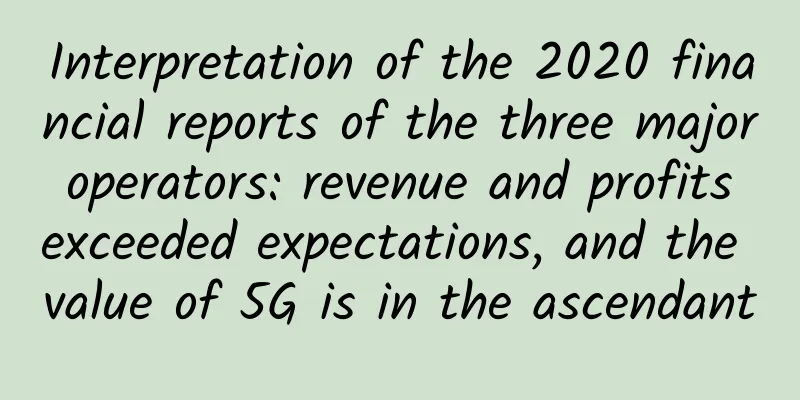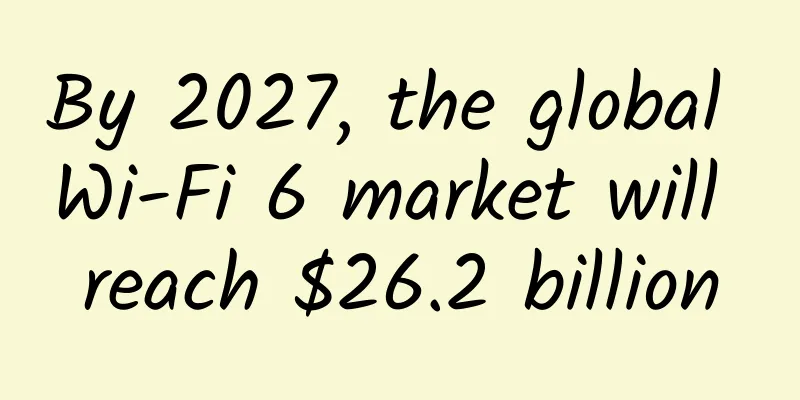Interpretation of the 2020 financial reports of the three major operators: revenue and profits exceeded expectations, and the value of 5G is in the ascendant

|
Recently, the three major operators released their 2020 financial reports. As the final year of the 13th Five-Year Plan, 2020 is the most special year for the communications industry and even for all industries around the world. Faced with the impact of the COVID-19 pandemic, the accelerated digital transformation of the economy and society, and the diversified evolution of industry and cross-border competition and cooperation, the three major operators have worked hard to overcome various difficulties and challenges, insist on making progress while maintaining stability, and promote high-quality development. In addition to objective factors, in the field of basic telecommunications services, large-scale growth has become a thing of the past. Network construction, speed increase and fee reduction, innovative reform and other measures have become the three mountains weighing on operators. But overall, in 2020, the three major operators showed a stable and positive operating trend, with both revenue and profit achieving positive growth. Among them, the growth rate of mobile data and Internet business revenue brought by consumer Internet traffic has slowed down, and the driving effect on operators' performance has declined significantly; while the revenue from ICT solutions such as cloud services and data centers serving government and enterprise customers has increased significantly, and has become the first engine of growth. In addition, the fixed value-added telecommunications business revenue, mainly IPTV, cloud computing, and big data, has also increased compared with last year, among which the increase in cloud service revenue is the most obvious. For operators, saving money requires more wisdom than making money. In the past year, the largest capital expenditure of operators was 5G network construction. In order to build 5G networks more intensively and efficiently, China Telecom and China Unicom have jointly pioneered co-construction and sharing. China Mobile and China Broadcasting Corporation have also announced joint construction, which further reduces network operating costs and greatly shortens the network construction cycle. However, operators also have to face another major fixed "expense" - speed increase and fee reduction. Previously released data show that since the continuous network speed increase and fee reduction in 2015, operators have made 260 billion yuan in profits by 2018; 180 billion yuan in profits in 2019; and 46 billion yuan in profits in 2020. In six years, the three major operators have cumulatively made nearly 500 billion yuan in profits. There are opportunities in crisis: double growth in revenue and profit in 20202020 is a challenging year. As Wang Xiaochu, Chairman and CEO of China Unicom, said, the 2020 epidemic brought certain challenges to the company's operations, especially in terms of business expansion, new user development, 5G construction and bad debt risks. However, the epidemic has accelerated the transformation and upgrading needs of the digital economy and brought new business opportunities. Overall, the three major operators have achieved growth in revenue and profits over the past year, especially compared with last year's performance, at least ranking among the "passing" ones. Data shows that China Mobile's operating revenue in 2020 was 695.7 billion yuan, a year-on-year increase of 3.2%, a significant increase from the previous two years, showing a good development momentum. Net profit was 107.8 billion yuan, a year-on-year increase of 1.1%. Profitability continued to maintain the leading level of international first-class operators, reversing the downward trend of net profit in 2019 and achieving steady growth. EBITDA was RMB 285.1 billion, a year-on-year decrease of 3.7%. China Telecom achieved operating revenue of RMB 393.6 billion, a year-on-year increase of 4.7%; service revenue of RMB 373.8 billion, a year-on-year increase of 4.5%, higher than the industry average; net profit of RMB 20.9 billion, a year-on-year increase of 1.6%. EBITDA was RMB 118.9 billion, a year-on-year increase of 1.4%. China Unicom achieved operating revenue of RMB 303.8 billion in 2020, a year-on-year increase of 4.6%, of which service revenue was RMB 275.8 billion, a year-on-year increase of 4.3%, higher than the industry average of 3.6%. The annual profit was RMB 12.492 billion, a year-on-year increase of 10.3%. Due to various objective factors, the outside world does not have too many extravagant expectations for the performance of operators in 2020, but overall, the operators have delivered a satisfactory answer. In the next two years, facing the saturation of 4G business and the continued increase in capital expenditures for 5G construction, operators will have more difficulties to overcome in order to maintain revenue and profit growth. Revenue structure continues to be optimized and the value of innovative business is highlightedIn recent years, basic telecommunications services have shown obvious signs of maturity, but with the continuous adjustment and optimization of operators' products, this part of the business has gradually recovered. Taking China Unicom as an example, China Unicom's mobile business development momentum continued to be released in 2020, and mobile service revenue and user ARPU have both increased month-on-month for three consecutive quarters. In 2020, China Unicom's mobile service revenue reached 156.7 billion yuan, turning from negative to positive year-on-year; mobile user ARPU reached 42.1 yuan, an increase of 4.1% year-on-year; fixed-line broadband access revenue increased by 2.4% year-on-year to 42.6 billion yuan. Over the past year, the three major operators have maintained a healthy development momentum in both ToC and ToB businesses, among which the industry digitalization representing ToB has a considerable income. In 2020, China Mobile's number of government and enterprise customers reached 13.84 million, a net increase of 3.56 million. Private line revenue reached RMB 24 billion, a year-on-year increase of 19.3%; DICT revenue reached RMB 43.5 billion, a year-on-year increase of 66.5%, contributing 2.6 percentage points to the increase in communication service revenue; among them, mobile cloud revenue reached RMB 9.2 billion, a year-on-year increase of 353.8%. In the past year, China Telecom's industry digitalization revenue reached RMB 84 billion, a year-on-year increase of 9.7%, and the network-wide cloud business revenue reached RMB 13.8 billion, a year-on-year increase of 58.4%. China Unicom's industrial Internet business revenue increased by 30.0% year-on-year to RMB 42.7 billion, accounting for 15.5% of the overall service revenue. Among them, ICT business revenue was RMB 13.4 billion, a year-on-year increase of 33.4%; IDC and cloud computing business revenue reached RMB 23.4 billion, a year-on-year increase of 26.1%; IoT business and big data business revenue reached RMB 4.2 billion and RMB 1.7 billion, respectively, a year-on-year increase of 39% and 39.8%, respectively. Today, my country is entering a new era of digital services. The level of economic and social informatization has been comprehensively improved, and the space for the Internet economy has been greatly expanded. It is expected that this part of the business will maintain rapid growth, and its share in operators' revenue will continue to expand. Continue to rapidly deploy and tap into the 5G blue ocean "gold mine"In 2020, despite the impact of the COVID-19 pandemic, the construction of my country's 5G network was not greatly affected. According to data from the Ministry of Industry and Information Technology, as of the end of last year, my country had built and put into operation a total of 718,000 5G base stations, achieving continuous coverage of all cities at or above the prefecture level and key counties and cities. The value of 5G to the communications industry is self-evident, and it is a blue ocean market that has just opened up for operators. Therefore, over the past year, operators have invested in 5G construction. In 2020, China Mobile's capital expenditure was 180.6 billion yuan, of which 102.5 billion yuan was used for 5G boutique network construction projects. The capital expenditure budget for 2021 is 183.6 billion yuan, of which 5G-related investment plans are about 110 billion yuan. In the past year, China Mobile has built about 340,000 new 5G base stations and opened a total of 390,000 5G base stations, providing 5G services to all prefecture-level cities, some county towns and key areas across the country. The number of 5G package customers has reached 165 million. In 2020, China Mobile comprehensively promoted 5G co-construction and sharing, and signed specific agreements with China Radio and Television in four areas: 5G network construction, network maintenance, market cooperation, and network usage fee settlement. 5G co-construction and sharing with radio and television will help accelerate 5G network coverage, further consolidate 5G network advantages, and reduce construction costs in an efficient and intensive manner. In 2020, China Telecom's 5G capital expenditure was RMB 39.2 billion. The joint construction and sharing with China Unicom saved both parties RMB 60 billion in capital expenditure, saving a lot of electricity bills, tower rentals, operation and maintenance costs throughout the year. In the past year, 380,000 5G base stations were built and put into use, achieving continuous coverage of 5G networks in all cities above the prefecture level, key counties and cities, and indoor areas of important buildings, with a maximum peak rate of 2.7Gbps, the highest in the world. In 2020, China Telecom's 5G package users reached 86.5 million, with a penetration rate of 24.6%. Telecom Chairman Ke Ruiwen pointed out that China Telecom's goal for 2021 is to increase 5G user packages by 80 million. It is estimated that 5G capital expenditure in 2021 will be about 39.7 billion yuan, and the goal is to increase the number of 5G base stations in use to 700,000. As a partner of China Telecom's 5G co-construction and sharing, China Unicom's 5G package users reached 70.83 million in 2020, and the penetration rate of 5G package users reached 23%, higher than the industry average of 20%. In 2020, China Unicom's 5G expenditure was about 34 billion yuan. By building the world's first and largest 5G co-construction and sharing network with China Telecom, the total number of 5G base stations has reached 380,000. When talking about the future investment trend of 5G, Wang Xiaochu, chairman of China Unicom, said that the investment will basically maintain about 70 billion yuan from 2020 to 2022, of which 5G investment will account for about 35 billion yuan. After three years, 5G investment will begin to decline. Unless 5G traffic finds a new breakthrough point and triggers a rapid increase in 5G traffic, in that case, timely adjustments will be made. |
<<: How big is the bandwidth of 1M cloud server? It is enough for 90% of websites
>>: Terminals have become a major obstacle to the development of 5G
Recommend
BudgetVM: 1Gbps unlimited traffic server starting from $84/month, 10-100Gbps bandwidth options, US/Japan data centers
BudgetVM is a foreign hosting company that has be...
An oscillation almost ruined my work. It turned out to be caused by an IP address conflict!
Switches are in the arena, and it is not okay to ...
The high-quality development of 5G still requires more active policy support
Recently, the three major telecom operators have ...
IPv6 upgrade causes major communication failure
This article is reprinted from the WeChat public ...
Wi-Fi in an IoT World
We’ve written quite a bit about Wi-Fi, but what I...
TMR: By 2026, the global smart manufacturing platform market will reach $15.93 billion
According to TMR, the global smart manufacturing ...
How Network Modernization Drives Digital Transformation
[[422647]] The fact is that the global outbreak o...
iOVZ: 48 yuan/month - dual core, 2G memory, 50G disk, 5M, Korean three-network SK line
iOVZ Cloud's regular promotion this month is ...
GSA: More than 100 commercial 5G networks launched worldwide
On September 25, according to foreign media repor...
HostKvm newly launched China Unicom CUVIP line VPS, 1G memory package starts at $5.2/month after 20% discount
Recently, more and more merchants have connected ...
How does the famous CDN acceleration service accelerate access and distribute content?
Hello everyone, I am Bernie, an IT pre-sales engi...
Hosteons announces that it will switch to KVM for free for OpenVZ users
Hosteons released the OpenVZ 7 VPS Migration to K...
China's digital economy reaches a turning point from big to strong
[[396176]] On April 25, the Cyberspace Administra...
HTTP connection management diagram
[[414965]] Hey guys, this is programmer cxuan, we...









